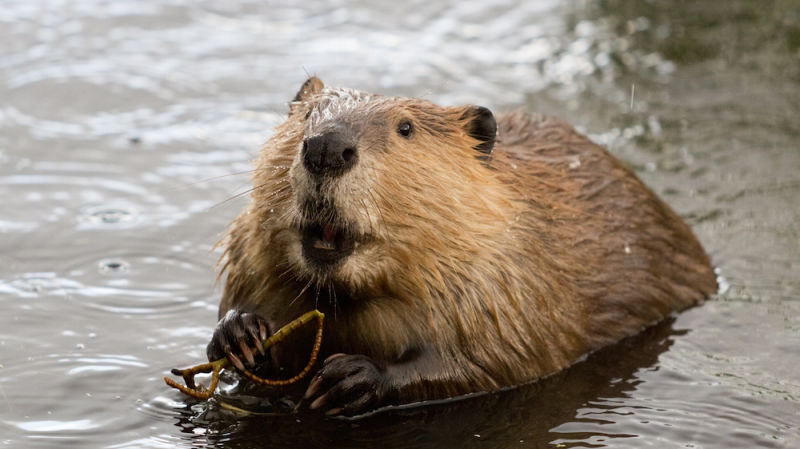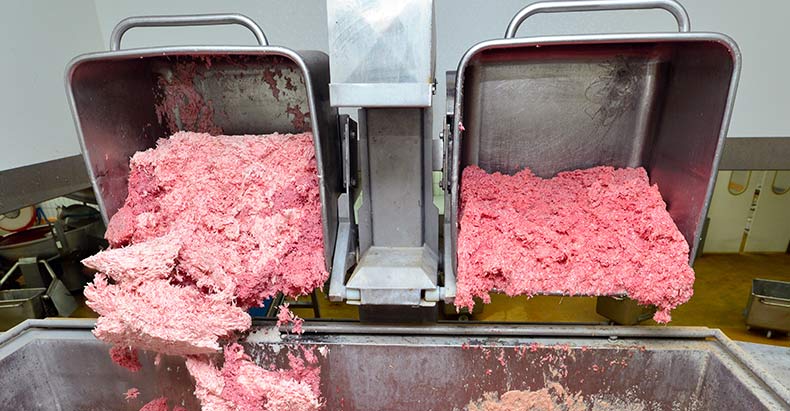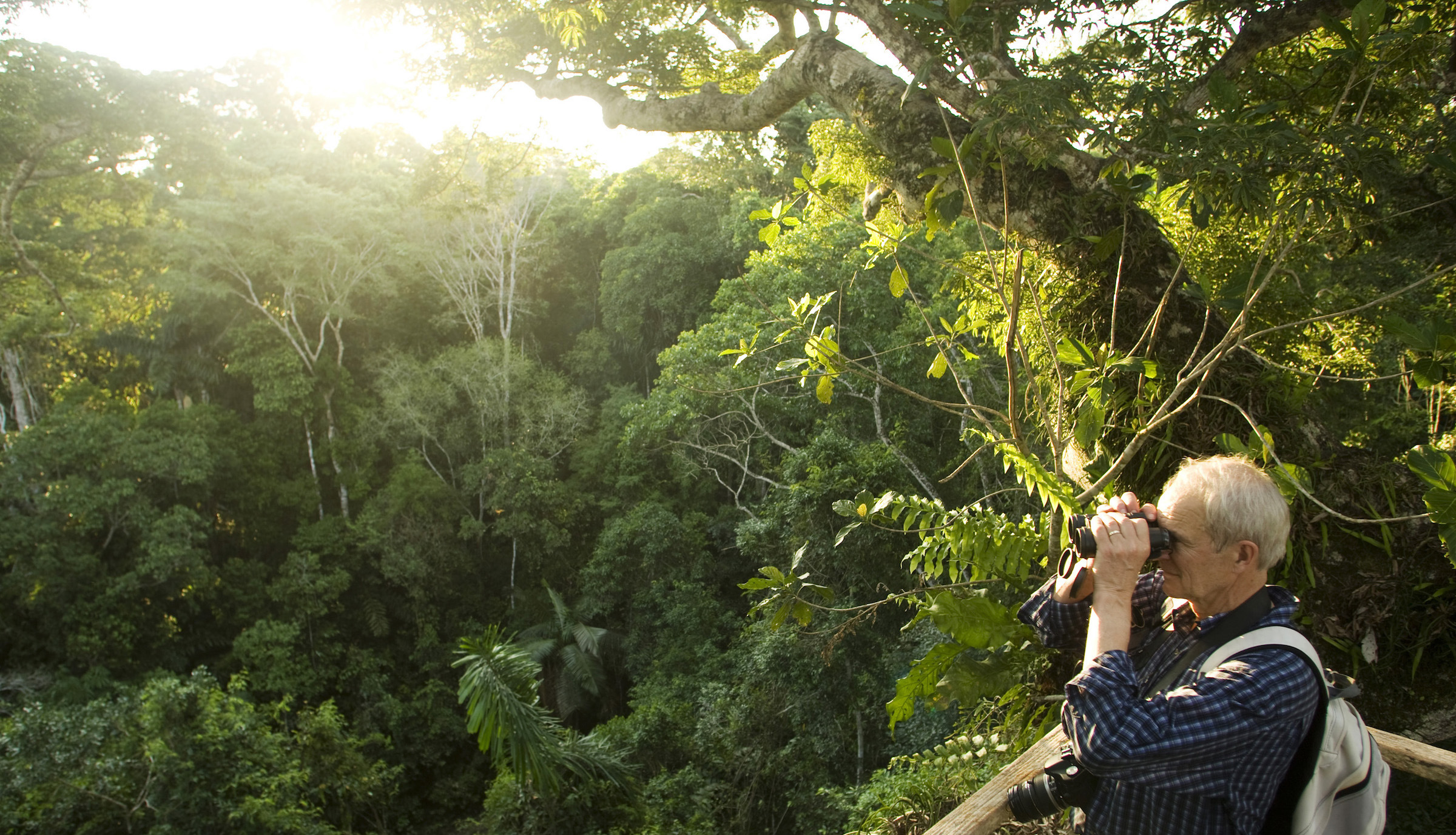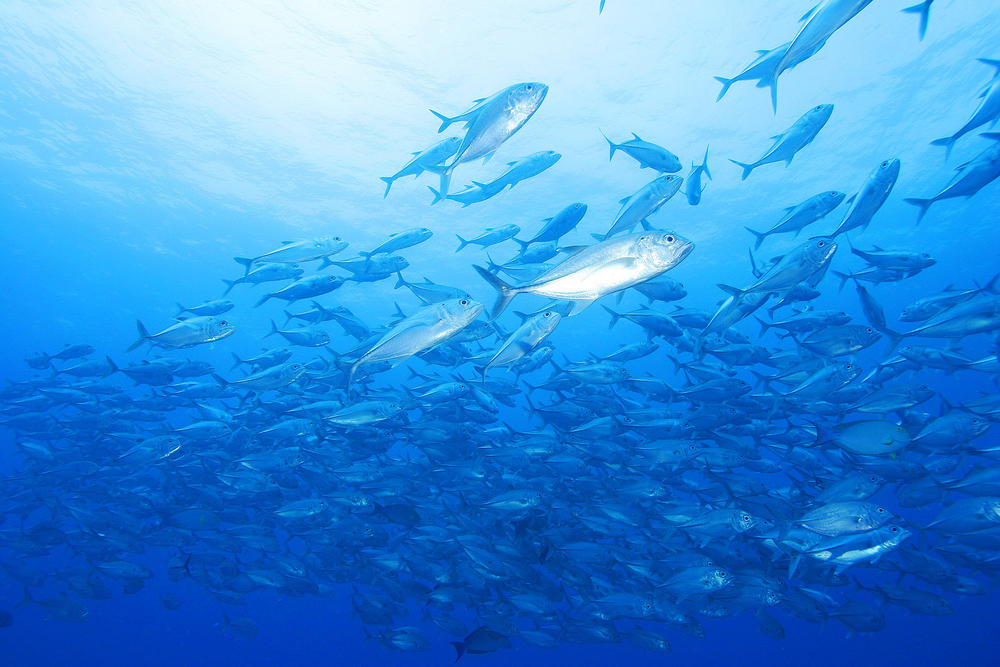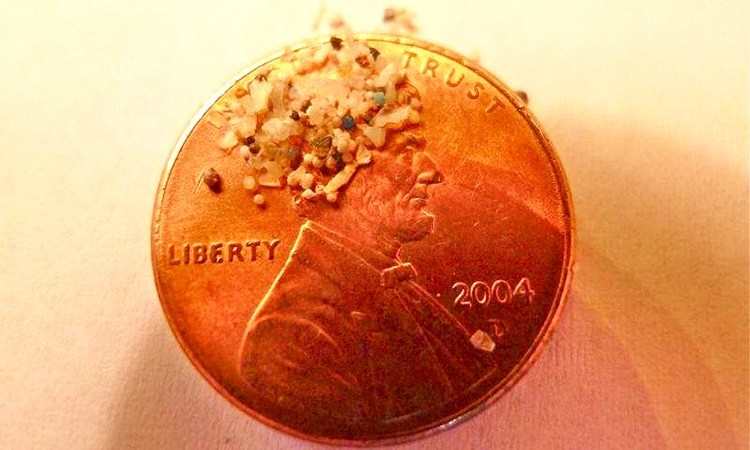Are Robots The Future of Farming Efficiency?
Are Robots the Future of Farming Efficiency?
Bosch is using a robot to make farming more efficient and reduce its environmental impact, Farming Life reports.
Deepfield Robotics, a Bosch startup, developed the robot called Bonirob, which is the size of a compact car.
The agriculture robot can monitor new crop varieties’ growth, their resistance to pests and how much fertilizer and water they need. Currently, plant scientists in a laboratory have to do these time-intensive tasks manually.
Bonirob also improves efficiency of day-to-day work in the fields. It can distinguish between crops and weeds based on the shape of their leaves and eliminates weeds manually, which means farmers don’t have to use toxic chemicals to kill weeks.
Farming Life says more efficient plant breeding is expected to play a major role in increasing agricultural output in the near future: yields must increase by 3 percent each year to keep up with population growth. The farming robot can help with this, Professor Amos Albert, general manager of Deepfield Robotics, tells the publication: “Over time, based on parameters such as leaf color, shape and size, Bonirob learns how to differentiate more and more accurately between the plants we want and the plants we don’t want.”
Oil operators are also turning to robots as they attempt to streamline drilling operations, cut down non-productive time and shave costs, according to a Lux Research report published earlier this month.
Floating Garden Cleans As It Grows In The Most Polluted Waterway in US
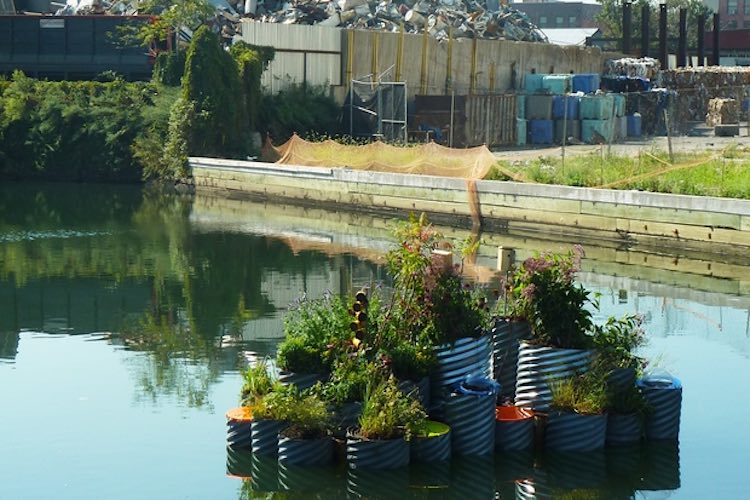
The Gowanus Canal in New York City is notorious for being one of the most polluted waterways in the U.S. Imagine everyone’s surprise when, three weeks ago, an oasis of pure greenery sprouted atop the surface of the river.
Not only is this improbable garden a breathtaking sight on the brackish water, but it is also cleaning the stream as it blooms.
The project, called GrowOnUs, is an experiment in “floating infrastructure” that utilizes a process called phytoremediation to tidy up the murky canal. Over 30 different kinds of plants act as sponges to purify, desalinate, and mitigate the chemicals affecting the waterway.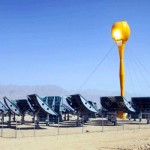
When a Solar Plant Becomes a Sculpture Garden, Tulip Power Blooms
The plants are grown inside the very same metal culvert piping used to carry sewage waste into the waterway. These “test tubes” are made buoyant by eco-friendly construction materials like coconut fibers and bamboo.
Balmori Associates, a New York company specializing in creating environmentally sustainable infrastructure since 1995, took action on the GrowOnUs project after receiving a $20,000 grant from the Cornelia & Michael Bessie Foundation.
According to Diana Balmori, three attempts had already been made to produce a sustainable patch of vegetation in the waters, but the pollution had been too much for the plants. Now, since using tougher, more conditioned greenery, the garden has been thriving.
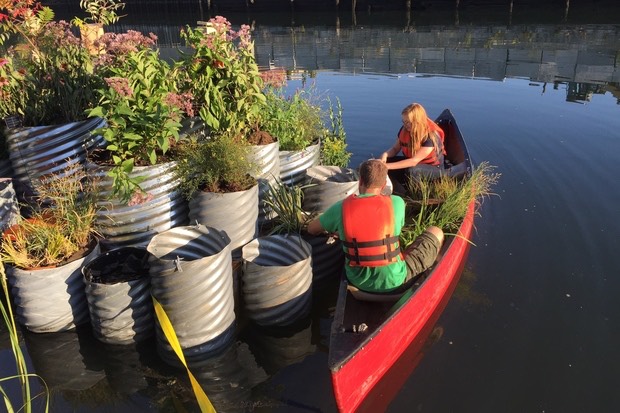 Homeless Shelter’s 80-Bed Rooftop Garden Cultivates Fresh Food and Job Skills
Homeless Shelter’s 80-Bed Rooftop Garden Cultivates Fresh Food and Job Skills
GrowOnUs, ideally, will deliver a positive change in shoreline protection, wildlife activity, and financial income for the city. It could also become the next wave in locally-grown food.
“We have pioneered floating landscapes, we now want to learn what can make these floating structures financially sustainable” said Balmori in a press release. “Dr. Michael Balick at the New York Botanical Garden suggested we grow herbs, low maintenance crops.”
See More Positive News Stories About Cutting Pollution
“In a few years NYC restaurants may be serving meals and drinks infused with herbs [and fruits] grown on one of these islands.”
(WATCH the video below to learn more)
Photos by © 2015 Balmori Associates
Burning Hell Coming for Mideast Deserts : DNews
If any place could be described as a living hell, it might be the desert regions of the Middle East. Hot, dry, dusty and arid, these harsh landscapes still manage to support cities populated by tens of millions of people who rely on air conditioning to survive.
Now scientists say that by the end of the century, the effects of climate change will push the region into a zone that surpasses the limits of human survival. They believe that most any outdoor activity will be hazardous.
“This is a significantly more severe type of heat wave than what people have experienced before,” said Elfatih Eltahir, professor of civil and environmental engineering at the Massachusetts Institute of Technology.
10 Nasty Surprises from Climate Change
Co-author Jeremy Pal, professor of civil and environmental engineering at Loyola Marymount University, said that the 2003 heat wave that killed 15,000 people in Europe “looks like a refreshing day” compared to the future conditions expected in some parts of the Middle East.
The pair’s paper is published today in the journal Nature Climate Change and examined when this area would surpass the combined heat and humidity reading, known as wet-bulb temperature, of 35 degrees Celsius (95 Fahrenheit). At this level, the body is unable to cool itself through normal processes of sweating and ventilation because there is too much water vapor in the air.
“If the environment can’t take any more water, the sweat on your body no longer evaporates,” said Kris Lehnhardt, assistant professor of emergency medicine at the George Washington University School of Medicine and Health Sciences. “Your body doesn’t cool anymore.”
11 Health Threats from Climate Change
Beyond this level of 35 degrees wet-bulb, (conditions of 100 degrees F, with a relative humidity of 80 percent), the body starts to go haywire, Lehnhardt explained.
After symptoms of headache, nausea and dizziness, the first organ affected is your brain. “People will start to have an altered mental status and behave in an unusual manner,” said Lenhart, who was not involved in the study. “If it gets really bad, they might have trouble walking, and then become unconscious.”
The two climate scientists used global and regional climate models with a very small geographic resolution. That means that they could pinpoint which areas would face the highest temperatures.
Global Warming Right Before Your Eyes
The affected cities include Doha (Qatar), Dharan (Saudi Arabia), Abu Dhabi (United Arab Emirates), Dubai, Kuwait City (Kuwait), as well as Bandar Abbas and Badar Mahshahr, Iran.
Because the Persian Gulf region lacks cloud cover or greenery, and because the gulf’s waters are shallow (which causes surface water to evaporate to the atmosphere), the entire area becomes both hot and humid in the summertime.
“People who have resources will live indoors,” said Eltahir.
US Cities Under 12 Feet of Sea-Level Rise
But he noted that there are poorer people in places like Yemen, communities that may be forced to migrate elsewhere to avoid the devastating effects of summer heat.
The annual pilgrimage of Muslims to Mecca, Saudi Arabia, will also be endangered because the ceremony takes place outdoors.
Ironically, the Persian Gulf states are also a center for petroleum and gas production, the same industry whose carbon emissions are responsible for the climate change driving the warmer planet, the scientists say.
Global Warming Could Threaten 1-in-6 Species
Just as people will suffer, so too, will the oil industry. That’s because petrochemical workers could find it too hot to maintain or repair production facilities in the searing heat, according to Pal.
Transportation, agriculture, aquaculture, fishing and any other industry that relies on moving things outdoors will also be affected, Pal noted.
But Lehnhardt, the doctor, says that humans living in the Persian Gulf will probably survive somehow, just as they do in places like the Arctic regions of Canada, Greenland or Asia.
“Humans are extremely adaptable and we find ways to survive in environments we shouldn’t be in anyway,” said Lehnhardt, who also studies the effects of space travel on humans.
“It will lead to a change in the way that homes are designed and cities are designed. It will lead to people making different choice about what they do.”
The Plan to Make California Wet By Bringing Back Beavers
Ending the drought in the West will require rain- not too much rain-and smarter ways to collect and store that water. But something else that can keep things moist? Believe it or not: Beavers.
According to a story in Water Deeply, a group of ecologists have a plan to help repopulate the Central Coast of California with Castor canadensis, the large beavers which once roamed the state in great numbers. (Not to be confused with their ancestors, giant beavers that were seven feet long.) The idea is that beavers are nature’s hydrologists, engineering the way that water travels through the landscape:
“Beavers aren’t actually creating more water, but they are altering how it flows, which creates benefits through the ecosystem,” says Michael Pollock, an ecosystems analyst and beaver specialist at the National Marine Fisheries Service Northwest Science Center.
Beavers were nearly eradicated by humans because they were interfering with our logging and fishing industries. But that’s exactly why beavers need to return. Rivers and streams that have been diverted by humans are designed to remove water quickly from the watershed, destroying local habitats for animals and making it more difficult for an ecosystem to recover from drought. Beavers build infrastructure which help to slow the flow of water, letting it recharge local aquifers, and preventing erosion which helps keep plants alive.
Not everyone is a fan of the Bring Back the Beaver campaign. Ecologists can’t agree where beavers originally lived, for one, so they aren’t sure where they should be reintroduced. And they don’t want to end up with an invasive species, which is what happened in South America. But some scientists aren’t waiting around for a consensus. The Yurok Tribal Fisheries Program is taking matters into its own hands, hiring humans to build their own beaver-like structures to mimic the rodents’ beneficial environmental impact. It sounds like a dam good idea.
[ Water Deeply]
Local Brazilian Start-Ups Challenge Status Quo; Experiment with New Ways of Doing Business
As Latin America’s largest economy and the host of the 2016 Olympic Games, Brazil is a regular fixture in international news. It’s also widely recognized for its agenda on sustainable development issues, especially for reducing deforestation and pioneering clean energy. However, progress remains uneven as the country is struggling to come to terms with one of the worst droughts in history, a chain of corruption scandals and continuing dependence on fossil fuels.
SustainAbility recently met with Álvaro Almeida and Rúbia Piancastelli of report:sustentabilidade, Brazil-based sustainability advisory firm and organizer of Sustainable Brands Rio, to talk about the country’s changing sustainability landscape.
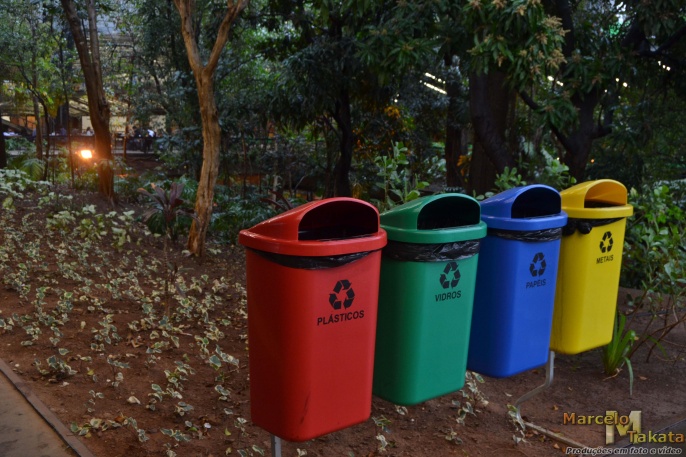
Aiste Brackley: How would you describe the current corporate sustainability landscape in Brazil? What were the dominant themes at this year’s conference?
report:sustentabilidade: With our conference, we seek to push the boundaries of conversation about corporate sustainability in Brazil, challenging ourselves and businesses to imagine what is possible. This year we decided that it was the right time to explore the topics of circular economy and innovation. While many Brazilian companies are working on reducing waste, their thinking predominantly remains embedded in linear models. We would like to challenge companies to think how the circular approach could be integrated into a business model from the very beginning. It is an entirely new way of thinking about design and production.
We also think that Brazilian businesses are ready for a more rigorous conversation about the sharing economy and business model innovation in large companies. This question is especially relevant in the context of the increasingly vibrant social innovation scene. The start-up scene is burgeoning in Brazil with many of them offering innovative solutions that large companies could potentially adopt and scale.
Could you share some examples of innovative corporate sustainability strategies by local companies?
Probably the most widely known example is that of the local beauty products manufacturer Natura. It is leading the field by setting ambitious net positive goals and planning its sustainability strategy as far as 2050. Coca-Cola and Natura are now jointly working with local açai growers in the Amazon to improve their livelihoods and reduce deforestation, a great example of collaboration between large companies.
Another interesting case is , Brazil’s largest retailer, which has also been a leader on sustainability issues. GPA has pioneered a progressive model of working with communities in the Rio de Janeiro and San Paolo neighborhoods, where its supermarkets are located.
In a way, many sustainability leadership examples in Brazil point to collaboration. Getting companies to unite their efforts, seeking synergies and common ground between parallel initiatives will be key to achieving impact.
Our surveys show that Latin America is one of the few regions where local companies dominate sustainability leadership rankings. In many other parts of the world, Unilever and Patagonia are universally seen as dominant players.
Yes, we also see that trend. We ran a survey of conference participants and Natura was overwhelmingly regarded to be the front-runner, with Itaú Unibanco and Unilever taking the second and third spots, respectively.
While we are seeing a lot of progress, for many businesses integrating sustainability into core operations remains to be a major challenge. It is often coupled with lack of a long-term vision and a focus on immediate, short-term issues.
To what extent is this absence of long-term perspective a result of relatively nascent corporate sustainability agendas? Or is it rather a consequence of the current political and economic climate?
Economic and political climate is very important but many Brazilian companies are also facing a challenge of progressing from the very basic understanding of sustainability as simply mitigating negative effects to actually creating net positive impact. I believe this transition is the next big mission for Brazilian companies.
The current economic crisis and corruption scandals have a big impact on business and especially on local companies that primarily rely on the Brazilian market. While global companies are also impacted, they are more resilient to these fluctuations. In their sustainability strategy, most multilateral corporations including Dow Chemical, Unilever, L’Oréal, rely heavily on guidance from corporate headquarters. However, in the past couple of years we have seen the Brazilian branches of some large international companies adopt sustainability strategies that are uniquely designed to address local challenges in Brazil, and that is a very welcome development.
What other sustainability issues are now top-of-mind for companies in Brazil?
Recent corruption scandals have had an effect on many aspects of life in Brazil, including business. Just like in so many other parts of the world, water scarcity is a major concern. The current water crisis is increasingly being linked by scientists to deforestation in the Amazon, another major challenge facing the country. Reducing waste is also a major issue on the corporate sustainability agenda. New environmental regulations, introduced a few years ago, are forcing companies to introduce new measures to reduce waste and rethink packaging. There is also a lot of interest by Brazilian companies in Sustainable Development Goals, with many pursuing partnerships through the UN Global Compact.
And while the Brazilian government is heavily invested in lead-up negotiations to the UN climate change conference in Paris (COP21), for most companies, the energy conversation is first and foremost about efficiency. Our economy remains to be heavily reliant on fossil fuels and hydropower and regulatory incentives are still lacking to advance other forms of renewable energy.
What is the next frontier for Brazilian companies?
Brazilian companies understand well the relevance of CSR and in the last 15 years have made a lot of progress improving sustainability management and embedding it in their governance. But I believe that the understanding of corporate responsibility remains limited. The next step for companies is to create solutions to the challenges that our society faces today and transform those challenges into business opportunities. This is the next big frontier and we are already seeing many promising examples that this transformation is under the way.
This is the third installment in a series of four blogs about Latin America. To find out more about sustainability issues shaping the debate in Latin America, view the presentation deck and listen to the recording of our mid-year Trends webinar. And, you can read our first and second installments of the series, too. For over 25 years SustainAbility has provided companies with timely intelligence and interpretation of emerging sustainability issues and trends. For more information about our bespoke trends service and how your company can benefit from it, please contact Aiste Brackley.
Consumer Reports Study Finds that Nearly All Ground Beef Sold in America Has Feces in It
The megalithic federal bureaucracy known as the U.S. Department of Agriculture is made up of 100,000 employees who are stationed at 4,500 locations across the country. Their mission statement, in part, reads “to promote agriculture production that better nourishes Americans.”
A recent study by Consumer Reports, however, shows that nourishing Americans consists of feeding them deadly superbugs, food poisoning pathogens, and feces.

While it’s not surprising to the readers of the Free Thought Project that the US government could fail so miserably in their stated mission, this recent study exhibits an unrivaled level of incompetence within this behemoth bureaucracy.
Consumer Reports tested several hundred packages of ground meat from stores across America, and their findings were shocking, to say the least.
According to the report,
New lab tests conducted by Consumer Reports found that of the 300 packages of ground beef purchased in stores across the country, almost all contained bacteria that signified fecal contamination.
More than 40 percent contained Staphylococcus aureus. Almost 20 percent contained Clostridium perfringens, which causes nearly 1 million cases of food poisoning annually, many related to beef.
A significant amount also contained superbugs, bacteria that are resistant to three or more classes of antibiotics. A key reason is the overuse of antibiotics on cattle farms.
The irony here is that local organic farmers who have harmed no one, are being raided by SWAT teams for selling raw milk, eggs, or grass fed beef. Meanwhile, millions of people are getting sick and dying across the country by government-subsidized factory farms.
In The Omnivore’s Dilemma, Michael Pollan points out how concentrated animal feeding operations (CAFOs), are dependent upon the cost of corn remaining low.
The government ensures these low corn prices by throwing billions of dollars a year the top 1 percent of corn farms in the United States. Since 1995, a whopping $85 billion has been taken from taxpayers and given to corn producers; all of this so you can have poop in your burger.
Aside from the horrific results of feeding corn to cows, there is also the apocalyptic problem of creating superbugs by massively dosing the factory farmed cattle with antibiotics to counter the horrendously dirty conditions in which they live.
“That practice (heavy use of antibiotics) can lead to the creation of antibiotic-resistant bacteria, a major public health problem. If you get sick from these bugs, your infection can be difficult to treat,” said Urvashi Rangan, Ph.D., director of Food Safety and Sustainability at Consumer Reports.
The consumer reports study wasn’t all doom and gloom, however. When they tested the sustainably produced, antibiotic-free, grass-fed cattle, they found that these were far less likely to have any of the bacteria.
“This study is significant, because it’s among the largest scientific studies to show that sustainable methods of raising cattle can produce cleaner and safer ground beef,” Rangan said.
Of course, “big government beef” is upset and defensive about these findings. When consumer reports contacted the National Cattleman’s Beef Association for a statement, they received this single comment from Kansas State University professor Mike Apley:
If all cattle were grass-fed, we’d have less beef, and it would be less affordable. Since grass doesn’t grow on pasture year-round in many parts of the country, feed lots evolved to make the most efficient use of land, water, fuel, labor and feed.
Amazingly enough, however, farmers can sustainably raise organic cattle to meet the market demand, without using government subsidized corn. Instead of massive amounts of chemical and mechanical inputs, the organic farmers can plan for the harsh winter months by saving the surplus from summer months.
The good news is that the demand is shifting from factory farmed cattle to sustainable and humanely raised cattle. Despite the best attempts of the USDA to regulate sustainable farms to death, they are thriving as demand increases.
Even some fast food chains are adopting this sustainable method. In December, California-based quick-service chain Carl’s Jr. rolled out the All-Natural Burger, which sources solely grass-fed beef from Austrailia.
Besides Carl’s Jr., a grass-fed burger chain called Farm Burger, has begun to spring up from coast to coast.
Besides sustainable beef, there is also the option of no beef. One of the fastest growing categories in food choice happens to be vegetarian.
In the information age, ignorance is a choice, and it seems that it’s a choice more, and more people are avoiding. While this study shows that we still have an uphill battle when it comes to healthy, non-taxpayer subsidized food, it is only a matter of time before we reach critical mass.
Coral Worldwide Threatened By Bleaching
- Corals worldwide are at risk from a major episode of bleaching which turns reefs white, scientists have confirmed.
The bleaching has hit reefs in the Pacific, Atlantic and Caribbean.
The US National Oceanic and Atmospheric Administration (NOAA) warned it may affect over 38% of the world’s reefs, and kill over 12,000 sq km of reefs.
The mass bleaching is caused by rising water temperatures resulting from two natural warm currents and exacerbated by man-made climate change.
Bleaching happens when corals under stress drive out the algae known as zooxanthellae that give them colour.
If normal conditions return, the corals can recover. But the process can take decades, and if the stress continues, the corals can die.
Reefs are under multiple threats including pollution, over-fishing, sedimentation and damage from boats and tourism.
The current worldwide bleaching episode is predicted to be the worst on record as the warming Pacific current, El Nino, increases in strength. Water temperatures are being driven further by a separate natural warm-water mass dubbed the Pacific Blob.
Man-made climate change also contributes, as the oceans are absorbing about 93% of the increase in the earth’s heat.
Additionally, corals face ocean acidification as CO2 emissions are absorbed into the oceans, changing the pH of seawater.
Some scientists are warning that spectacular reefs as we know them – with branching corals and fan corals – are unlikely to survive changes in temperature and pH by the end of this century. That’s if they are not killed first by other damaging local activities.
The current bleaching episode was predicted by NOAA and confirmed by researchers and citizen scientists in the Caribbean. The main groups involved are XL Catlin Seaview Survey, the University of Queensland, and Reef Check.
Although reefs represent less than 0,1% of the world’s ocean floor, they help support about a quarter of all marine species. The NOAA says the livelihoods of 500 million people and income worth over $30bn (£19,6bn) are at stake.
Reefs are the breeding ground for tropical fisheries. They also provide shelter from the waves for tropical islands and bring invaluable tourist income.
“Just like in 1998 and 2010, we’re observing bleaching on a global scale, which will cause massive loss of corals. With people relying on fisheries and reefs for sustenance, the repercussions could be potentially disastrous,” said Prof Ove Hoegh-Guldberg from the University of Queensland.
Prof Rupert Ormond, Secretary of the International Society for Reef Studies, told BBC News: “Although corals may live for several days after they bleach, they then usually die. They may recover – but only if the sea temperature drops within a week or so. Mostly it takes much longer, so the reef ends up covered with dead corals, especially on its upper parts.
“The reefs may slowly recover if new coral colonies come in from outside, but this may take years or decades. I know coral reefs in Kenya that lost most of their corals in 1998 and they still only have a few percent of the corals once there.”
Follow Roger on Twitter @rharrabin
Chernobyl Wildlife Thriving Decades After Nuclear Accident : DNews
On a haunting, contaminated landscape devoid of humans, animals are now thriving. So finds a new study on wildlife populations in the Chernobyl Exclusion Zone, late of the former Soviet Union and now part of Ukraine.
In 1986, Chernobyl was the site of of a nuclear reactor accident, the radiation from which caused the displacement of human life from an area of more than 1,000 square miles. Only animals were left to roam the the area.
Today, a multi-university study finds, the exclusion zone has abundant roe deer, red deer, elk, and wild boar — so many that the researchers say their numbers rival those of nature preserves in the region that are not contaminated.
Wolves, they add, are seven times more populous than animals in those radiation-free areas.
“It’s very likely that wildlife numbers at Chernobyl are much higher than they were before the accident,” said Jim Smith, of the University of Portsmouth, in a press release.
While earlier studies had shown sharp drops in wildlife thanks to radiation effects, the new data, culled from long-term census information and helicopter surveys, argues that mammals are back with a vengeance.
“These results demonstrate for the first time that, regardless of potential radiation effects on individual animals, the Chernobyl Exclusion Zone supports an abundant mammal community after nearly three decades of chronic radiation exposure,” the scientists wrote.
“This doesn’t mean radiation is good for wildlife,” Smith cautioned, “just that the effects of human habitation, including hunting, farming, and forestry, are a lot worse.”
The team’s findings have been published in the journal Current Biology.
Can Celebrity Voices Create Mass Environmental Awareness
Call Me Reminiscent I like to be reminded of how connected we are to all the particular systems and organisms whom we share the planet with. So I recently returned to an old channel called NatureIsSpeaking.org to admire Hi-Def scenes of this blue rock we call Earth. Helping in the build-up of admiration for our irrefutable symbiosis with air, oceans, rainforest, coral reef, etc. …
Shell says it will abandon oil exploration in Alaska Arctic
Update 4 a.m. Monday:
In midday trading in London, Shell’s share price was down 1.7 percent in a weak overall market after opening on news that the company will cease exploration in the Alaska Arctic.
But an industry analyst told The Wall Street Journal he believes Shell’s investors will generally be happy with the development.
“Investors don’t want Shell to deliver more [capital expenditures] into Alaska,” Bernstein research analyst Oswald Clint told WSJ. “I imagine investors will be OK with a $1 billion hit versus tens of billions in the future.”
————
Sunday night story:
Royal Dutch Shell will cease exploration in Arctic waters off Alaska’s coast following disappointing results from an exploratory well backed by billions in investment and years of work.
The announcement was a huge blow to Shell, which was counting on offshore drilling in Alaska to help it drive future revenue. Environmentalists, however, had tried repeatedly to block the project and welcomed the news.
Shell has spent upward of $7 billion on Arctic offshore exploration, including $2.1 billion in 2008 for leases in the Chukchi Sea off Alaska’s northwest coast, where an exploratory well about 80 miles off shore drilled to 6,800 feet but yielded disappointing results. Backed by a 28-vessel flotilla, drillers found indications of oil and gas but not in sufficient quantities to warrant more exploration at the site.
“Shell continues to see important exploration potential in the basin, and the area is likely to ultimately be of strategic importance to Alaska and the U.S.,” Marvin Odum, president of Shell USA, said in The Hague, Netherlands. “However, this is a clearly disappointing exploration outcome for this part of the basin.”
Shell will end exploration off Alaska “for the foreseeable future,” the company said, because of the well results and because of the “challenging and unpredictable federal regulatory environment in offshore Alaska.
The Burger J well drilled this summer will be plugged and abandoned, Shell spokeswoman Megan Baldino said. The two rigs mobilized by Shell for its Chukchi work, the Polar Pioneer and the Noble Discoverer, will be heading south, along with the support vessels, she said. “We’ll begin demobilizing now,” she said late Sunday. That process will take “as long as it takes to do it safely,” she said.
Baldino said no decisions have been made yet about Shell’s workforce, and she did not have figures on Sunday night for total employees and contractors. But the pullout will mean “lower staff” numbers, she said.
Shell’s decision to cease offshore Arctic exploration affects both the Chukchi and the Beaufort. Its leases in the Chukchi are scheduled to expire in 2020 and most of its Beaufort leases are scheduled to expire in 2017, according to a status report from the Bureau of Ocean Energy Management.
Margaret Williams of the World Wildlife Fund in Anchorage, called the news of Shell’s withdrawal stunning.
“That’s incredible. That’s huge,” she said. “All along the conservation community has been pointing to the challenging and unpredictable environmental conditions. We always thought the risk was tremendously great.”
Environmental groups said oil exploration in the ecologically fragile Arctic could lead to increased greenhouse gases, crude oil spills and a disaster for polar bears, walrus and ice seals. Production rigs extracting oil would be subject to punishing storms, shifting ice and months of operating in the cold and dark. Over the summer, protesters in kayaks unsuccessfully tried to block Arctic-bound Shell vessels in Seattle and Portland, Oregon.
“Polar bears, Alaska’s Arctic and our climate just caught a huge break,” said Miyoko Sakashita, oceans program director for the Center for Biological Diversity, in a statement. “Here’s hoping Shell leaves the Arctic forever.”
Monday was Shell’s final day to drill this year in petroleum-bearing rock under its federal permit. Regulators required Shell to stop a month before sea ice is expected to re-form in the lease area.
The U.S. Geological Survey estimates U.S. Arctic waters in the Chukchi and Beaufort seas contain 23 billion barrels or more of recoverable oil in total. Shell officials had called the Chukchi basin “a potential game-changer,” a vast untapped reservoir that could add to America’s energy supply for 50 years.
Shell had planned at least one more year of exploration with up to six wells drilled.
A transition to production could have taken a decade or longer.
Shell had the strong backing of Alaska officials and business leaders who want a new source of crude oil filling the trans-Alaska pipeline, now running at less than one-quarter capacity.
Charles Ebinger, senior fellow for the Brookings Institution Energy Security and Climate Initiative, said in an interview that a successful well by Shell would have been “a terribly big deal,” opening an area that U.S. officials say contains 15 billion barrels of oil.
While oil prices have dropped significantly in recent years and nations have pushed for cleaner energy sources, analysts predict that the world between 2030 and 2040 will need another 10 million barrels a day to meet growing demand, especially in developing countries, Ebinger said.
“Areas like the Arctic are one of the areas that, if we’re going to be able to do this, we need to examine,” he said.
Shell in 2012 sent drill rigs to the Chukchi and Beaufort seas but was not allowed to drill into oil-bearing rock because the containment dome had been damaged in testing.
The company’s vessels suffered serious setbacks getting to and from the Arctic.
One drill vessel broke loose from its towline in the Gulf of Alaska and ran aground near Kodiak Island. Owners of the leased Noble Discoverer, which drilled in the Chukchi and is back this year, pleaded guilty to eight felony maritime safety counts and paid a $12.2 million fine.
That was proof of Shell’s Arctic incompetence, critics said.
Odum called drilling off Alaska’s coast the most scrutinized and analyzed oil and gas project in the world and said he was confident Shell could drill safely.
Alaska Dispatch News reporter Yereth Rosen contributed to this report.
Can A Grandmother From A Hunter Gathering Tribe Become A Solar Engineer?
We’re all looking for stories of hope – that the world can be changed, that we are not limited by our culture, our backgrounds, our histories – and few stories are as inspirational as that of Lucy Naipanoi, a grandmother of Maasai, one of the last hunter gatherer tribes left on the planet. With the …
Norway rewards Brazil with $1 billion for keeping the Amazon full of trees
Much of South America’s Amazon rainforest will continue to be clean, lush, and green-thanks in part to a country on the other side of the world.
In 2008, when the Amazon was facing a severe deforestation crisis, Norway, a country made rich from oil and gas production (and the biggest donor to protect tropical rainforests), pledged $1 billion to the government of Brazil if it could slow down the destruction. Doing so would protect the forest’s wildlife and also enormously reduce climate-harming greenhouse gas emissions, which are produced when forests are burned to make way for human development.
Brazil has more than risen to the task. By enforcing strict protection laws, promoting education efforts, and withholding loans to local counties that clear too much of the forest, the country has scaled back its forest destruction rate by 75%. It’s estimated that Brazilian farmers and ranchers have saved more than 33,000 square miles (roughly 53,100 square kilometers) of forest-equivalent to 14.3 million soccer fields-from being cut down.
This week, an applauding Norwegian government said it will pay out the country’s final $100 million-rounding out its $1 billion promise-to Brazil at a December UN summit on climate change. In a statement, UN Secretary-General Ban Ki-moon called the deal an “outstanding example” of international collaboration on sustainability.
Brazil’s blazing success in deforestation reduction is, indeed, a model for other countries-particularly the others that occupy the Amazon rainforest. Its Norway-subsidized efforts have translated into the largest emissions cut in the world, preventing roughly 3.2 billion tons of carbon dioxide emissions. That’s, by the way, how much America would save by taking all the cars off its roads for three years.
Save the bees with seed bombs
Seed bombs began as a fun and friendly tactic for greening abandoned lots in urban spaces. “Guerrilla gardeners” throw balls of seeds and fertilizer into fenced-off spaces that are otherwise neglected, such as brownfields or land in zoning limbo.
Now, a California company is using seed bombs as a strategy to fight the disappearance of bees. Ei Ei Khin and Chris Burley started Seedles with the aim of spreading bee-friendly wildflowers in neighborhoods around the country. Their goal is to grow 1 billion wildflowers with the help of colorful seed balls, a project they call “Grow the Rainbow.”
Bee populations have been dropping for about a decade. Scientists think there are a number of contributing factors to colony collapse, including the proliferation of certain pesticides, parasites, and even stress. But a decline in natural habitat-along with the loss of bees’ preferred wildflowers -is also a big factor. That’s how Seedles hopes to help, by encouraging people to plant more flowers.
 © Seedles
© Seedles
Seedles creates seed balls with wildflowers native to six different regions of the United States. For example, the Midwest mix may include wild perennial lupine, lemon mint and butterfly weed. The seeds are rolled up with organic compost to fertilize the seeds, and non-toxic color powders to add a bit of fun. The balls can be tossed anywhere you want flowers to grow, and with the help of some rain and sun will start to sprout.
For Khin and Burley, helping the bees is part of building a more sustainable food system, which is dependent on pollinators for many foods. Burley told Bay Area Bites that the company is partnering with like-minded local food companies, to give away seed balls and raise awareness about the connection between bees and food.
A pack of 20 seedballs sells for $13.00 on the Seedles website. Or if you’re feeling crafty, check out this DIY tutorial on Gardenista.
Greenpeace report: 100% renewables possible worldwide by 2050
Steve Howard, Ikea’s sustainability guru, once argued that 100 percent sustainable was an easier goal than 80 percent or 50 percent, because once you set your mind to an ambitious goal, everyone gets on board and does what needs to be done. Plus, you no longer have to spend time and resources investing in an out-of-date paradigm that will eventually be phased out anyway.
That might be true of a company like Ikea, but does it still hold true for entire countries? And what about the whole world? Well, we may be about to find out.
A new report from Greenpeace called Energy [R]evolution 2015, created in collaboration with the Institute of Engineering Thermodynamics, Systems Analysis & Technology Assessment at the German Aerospace Center, sets out a truly ambitious scenario: a 100 percent renewable energy powered global economy by 2050. And that doesn’t just mean zero carbon electricity grids. It means everything-transportation, electricity, heating etc,-coming from entirely renewable resources, even without the need for nuclear power. (This last point will be controversial in many circles.)
Now, I haven’t had the chance to dig through the report in detail-and am not qualified to judge how realistic it is anyway-but I will say that Greenpeace has a (perhaps surprisingly) good track record when it comes to predicting renewables growth -beating out the much more conservative predictions made by the IEA, Goldman Sachs or the US Department of Energy in terms of accuracy.
The authors of the Greenpeace report are by no means the only people beginning to think in terms of 100 percent renewables. We already have roadmaps for how every state in the US could achieve 100 percent renewable energy by 2050, the Australian Capital Territory just committed to 100 percent renewable electricity by 2025, and New Zealand will be at 90 percent renewables by the same date.
Of course possible and probable are not the same thing at all. From a strong global deal at the Paris climate talks to ambitious commitments from businesses and communities, and from local, national and international government bodies alike, there are many preconditions for Greenpeace’s scenario to pan out.
The costs will be tremendous. But the benefits will be too-not least because, authors claim, the report provides a pathway for keeping total cumulative emissions between now and 2050 to 667 gigatonnes, a figure comfortably within the 1,000 gigatonne range considered “safe” by the International Panel on Climate Change (IPCC).
Oh, and it would create jobs and cut the catastrophic levels of air pollution-related deaths too.
Please enable JavaScript to view the comments.
Why This Week Is Huge For Climate Action
Climate

Monday marks the beginning of a week full of national and global action to combat climate change and push for environmental justice. Events ranging from the United Nations’ sustainability assembly to climate change rallies on the National Mall are all happening over the course of this week, in coordination with Pope Francis’ visit to the United States.
This week, the United Nations is meeting to adopt a new 15-year plan for sustainable development. The plan outlines 17 broad goals and 169 specific targets to end world poverty, improve health and education, ensure gender and racial equality for all, implement sustainable building and agricultural practices in impoverished countries, conserve world oceans, and take urgent action to combat climate change. These Sustainable Development Goals replace the previously developed Millennium Development Goals and are intended to be achieved by 2030.
Right now there are no specific plans on how to measure the progress of each target. The goals will be discussed at the Sustainable Development Summit scheduled to take place September 25 to 27, preceding the annual U.N. general assembly on September 28 in New York City.
Critics of the Sustainable Development Goals are calling the targets “too broad,” while supporters are saying that “there is no choice but to go big in a world of expanding population, growing inequality, dwindling resources and the existential threat from global warming,” according to the Global Gazette.
The goals clearly emphasize the need to connect the impacts of climate change to gender and racial equality – specifically women in developing and impoverished countries. With women often being charged with providing critical resources such as food and water, as well as making up the majority of the agricultural workforce, sustainability movements have been pushing the importance of women’s rights in the realm of environmental protection.
“I urge partners across the world to embrace the ambition embodied in the new set of goals. I look forward to working together to deliver on the unfinished MDG commitments, tackle inequality and meet the new challenges that have emerged across the three dimensions of sustainable development – economic, social and environmental,” Secretary-General Ban Ki-moon said at a press conference in New York on September 18.
Complimenting this new season of goal setting, the Climate Group kicked-off its 7th annual “Climate Week NYC” Monday at the United Nation’s Headquarters in New York City. This week-long event is intended to highlight bold climate action from business and political leaders, as well as set sights for furthering renewable energy growth. Leaders such as U.S. Secretary John Kerry, French Foreign Minister Laurent Fabius, World Bank Group President Jim Yong Kim and Ban Ki-Moon spoke at last year’s conference, making it the largest thus far.
Under-pinning this week’s climate action, “Popemania” is sparking even further public action towards environmental and social justice. Cities across the U.S. East Coast have been anticipating Pope Francis’ first-ever visit from September 22 to the 28. Americans are expecting to hear him speak on the moral case of climate change, along with other social issues. Given his historically progressive stance towards people contributing to climate change, all signs point to Francis making climate a major component of his visit.
“Climate change is a global problem with grave implications: environmental, social, economic, political and for the distribution of goods. It represents one of the principal challenges facing humanity in our day,” he wrote is his 192-page papal encyclical earlier this year. In his words, “climate is a common good” and stronger action must be taken in order to protect it.
Francis will be speaking at the United Nations in New York on Friday, September 25, the day after he plans to deliver a speech to Congress. It is not confirmed that his speech will be centered on environmental action, but several environmental groups have organized a climate rally and free concert on the National Mall at the same time. Over 200,000 people are expected to attend and call on political leaders to follow Pope Francis’ lead in demanding for climate justice.
This week’s wide mix of environmental and global goal-setting are paving the way for further climate action expected at the United Nations climate conference in Paris later this year.
An Uncertain Future for Our Living Blue Planet
A new report on the health of the ocean finds that the marine vertebrate population has declined by 49 percent between 1970 and 2012.
WWF’s Living Blue Planet Report tracks 5,829 populations of 1,234 mammal, bird, reptile, and fish species through a marine living planet index. The evidence, analyzed by researchers at the Zoological Society of London, paints a troubling picture. In addition to the plummeting number of marine vertebrate species, populations of locally and commercially fished fish species have fallen by half, with some of the most important species experiencing even greater declines.
These findings coincide with the growing decline of marine habitats, where the deforestation rate of mangroves exceeds even the loss of forests by 3-5 times; coral reefs could be lost across the globe by 2050; and almost one-third of all seagrasses have been lost.
Global climate is one of the major drivers causing the ocean to change more rapidly than at any other point in millions of years. The oceans store huge quantities of energy and heat, but as the climate responds to increasing carbon emissions, the exchange intensifies. This may result in extreme weather events, changing ocean currents, rising sea temperatures, and increasing acidity levels-all of which aggravate the negative impacts of overfishing and other major threats such as habitat degradation and pollution.
Finding solutions for saving oceans
Though the challenge seems immense, it’s possible for governments, businesses, communities and consumers to secure a living ocean. To reverse the downward trend we need to preserve the oceans natural capital; produce better; consume more wisely; and ensure sustainable financing and governance.
Our ocean needs a strong global climate deal and work is already underway as President Obama and leaders of the Arctic nations recently pledged to work together to boost strong action on climate change. But more needs to be done to prioritize ocean and coastal habitat health.
Speak up for oceans! Together we can make a difference by halting the depletion of the ocean and restoring damaged ecosystems for species and people. Read the Living Planet Report 2014.
Banning Microbeads Offers Simple Solution to Protect Our Oceans
An outright ban on the common use of plastic ” microbeads” from products that enter wastewater is the best way to protect water quality, wildlife and resources used by people, a group of conservation scientists suggest in a new analysis.
These microbeads are one part of the microplastic problem in oceans, freshwater lakes and rivers, but are a special concern because in many products they are literally designed to be flushed down the drain. And even at conservative estimates, the collective total of microbeads being produced today is enormous.
In an article just published in the journal Environmental Science and Technology, scientists from seven institutions say that nontoxic and biodegradable alternatives exist for microbeads, which are used in hundreds of products as abrasive scrubbers, ranging from face washes to toothpaste. Around the size of a grain of sand, they can provide a gritty texture to products where that is needed.
“We’re facing a plastic crisis and don’t even know it,” said Stephanie Green, the David H. Smith Conservation Research fellow in the College of Science at Oregon State University and co-author of this report.
“Part of this problem can now start with brushing your teeth in the morning,” she said. “Contaminants like these microbeads are not something our wastewater treatment plants were built to handle and the overall amount of contamination is huge. The microbeads are very durable.”
In this analysis and using extremely conservative methodology, the researchers estimated that 8 trillion microbeads per day are being emitted into aquatic habitats in the U.S.-enough to cover more than 300 tennis courts a day. But the other 99 percent of the microbeads-another 800 trillion-end up in sludge from sewage plants, which is often spread over areas of land. Many of those microbeads can then make their way into streams and oceans through runoff.
“Microbeads are just one of many types of microplastic found in aquatic habitats and in the gut content of wildlife,” said Chelsea Rochman, the David H. Smith Conservation Research postdoctoral fellow at the University of California/Davis and lead author on the analysis.
“We’ve demonstrated in previous studies that microplastic of the same type, size and shape as many microbeads can transfer contaminants to animals and cause toxic effects,” Rochman said. “We argue that the scientific evidence regarding microplastic supports legislation calling for a removal of plastic microbeads from personal care products.”
Even though microbeads are just one part of the larger concern about plastic debris that end up in oceans and other aquatic habitat, they are also one of the most controllable. With growing awareness of this problem, a number of companies have committed to stop using microbeads in their “rinse off” personal care products and several states have already regulated or banned the products.
The researchers point out in their analysis, however, that some bans have included loopholes using strategic wording. Many microbeads are used in personal care products that are not “rinse off,” such as deodorants and cleaners. And some regulations use the term “biodegradable” to specify what products are allowed-but some microbeads can biodegrade just slightly, which may allow their continued use.
If legislation is sought, “new wording should ensure that a material that is persistent, bioaccumulative or toxic is not added to products designed to go down the drain,” the researchers wrote in their report.
“The probability of risk from microbead pollution is high, while the solution to this problem is simple,” they concluded.
YOU MIGHT ALSO LIKE
Marine Species on ‘Brink of Collapse,’ Says WWF Report
California Senate Passes Nation’s Strictest Ban on Microbeads
Hawaii on Verge of Worst Coral Bleaching in History as Water Temperatures Soar
Beijing banned cars for 2 weeks and the sky turned perfectly blue. Guess what happened the next day?
China marked the 70th anniversary of their victory during World War II in the only way possible: a ginormous parade.
On Sept. 3, 2015, Victory Day kicked off with a massive military parade through Beijing.

The celebration included 12,000 troops in 50 different military formations along with hundreds of fighter jets. Veterans and soldiers ranging from 20 to 102 years old participated. Parade training was apparently so intense that multiple officers reported losing 10 pounds or more.

Blue sky at night? Parade Day delight!
A parade this size takes months, sometimes even years, of preparation.
And in the case of Beijing’s Victory Day parade, numerous restrictions were put in place leading up to the festivities. Hundreds of factories were shuttered, and half of the 5 million registered cars in the city were banned from driving in the main urban hub.
Say what you will about spending government resources on a giant party, but in this case, it definitely paid off.

An average day in Beijing clocks in on the Air Pollution Index at around 160 (out of 500), which means adverse health effects for absolutely everyone (by comparison, an average day in the worst U.S. cities is said to be around 125). But by parade day, it had dropped to 17.

Grey sky at morning? Air pollution warning.
The day after the Victory Parade, cars were allowed to return to the roads – and the Air Pollution Index in parts of the city immediately returned to an unhealthy 160 out of 500.
Want to see the difference? Here’s how Beijing looked in June:

Here’s Beijing during the Victory Day parade in September:

And here’s Beijing less than one week later. Just in case you thought they were having a hazy day or something.

The sky is back to looking bleak, but the future doesn’t have to be. What happened before the Victory Day parade shows that a sunny change is still possible.
Air pollution is bad. Carbon emissions are bad. Cars are bad. We’ve all heard it before. But what we may not have realized is how much power we have to change things.
What happened in Beijing shows us – yes, how grim the situation is, but also just how easily we can change it.

By cutting back on cars and other emissions for a mere two weeks, Beijing underwent a beautiful and healthy transformation. And yet, all it took was one day of business-as-usual to bring Beijing crashing back into the danger zone.
It’s something to consider the next time you get behind the wheel. We can ensure a future of blue skies if more of us walked to work, rode our bikes, or crammed onto public transportation – even just a few times a week.
Those blue skies sure look nice to me.





